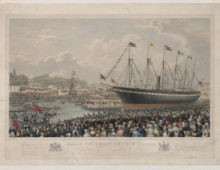The Surgeon’s Blade: The Sad Case of Captain St Pol
February 9, 2018 - Mick Crumplin in News & Blog Posts, The Surgeon's Blade
Mick Crumplin’s latest medical blog is the gory tale of an officer who refused to have his leg amputated
St Pol, an officer in the 7th or Royal Fusiliers was about to scramble up the great breach at Badajoz, during the furious and multiple assaults on that place on the night of 6 April, 1812. Multiple bloody assaults up the rubble of the breach, through cheveaux de fris, small arms fire and explosive devises, had failed to overcome the strong French defences.
Theofficer was standing in the breach when he was struck by a French musket round on the rear aspect of his thigh muscles. He bled a good deal, fell, staggered a small way and then was assisted to his tent, where his wound was bound. Surgeon George James Guthrie serving in Cole’s 4th division, saw him the following day. The haemorrhage had ceased the previous night. A lump was felt just beside the inner aspect of his knee-cap. Guthrie felt this and, after cutting down on it, removed the ball.
The surgeon felt into the wound cavity with his finger. It passed into the knee-joint, but he could not pass the finger into the entry wound. Since the patient had walked a little and no splinters of bone were felt in the joint, it was assumed that there was no significant bony injury to the limb. Nevertheless, the joint was damaged and the risk of poor healing, infection and a septic death seemed real. Amputation was probably the ‘safer’ course of action. The patient refused.
It was decided that an above knee (ie secondary) amputation should be carried out
On the 8th April, the town’s status was more stable and the heat under canvas being unbearable, the captain was moved into Badajoz. On the 9th, when Guthrie visited the patient, his injured leg was cooler than the other and was marbled and tallow-white in colour. St Pol’s femoral artery had been divided by the missile. There were blisters on the foot, which was, by then, a fine green colour. The early changes of gangrene, through lack of blood supply, had set in. By the 12th, the gangrene had advanced. It was decided that an above knee (ie secondary) amputation should be carried out. There were 16 arteries to be ligated and the wound could not be properly closed. St Pol gradually died on the 24th April.
Guthrie dissected the amputated limb and found a cavity full of old blood and clots. This communicated with the artery by a small fissure. The patient had died of blood loss, sepsis and exhaustion. The decision to amputate was too late (this had been the patient’s decision). The original decision to remove the leg was correct – St Pol had a major joint opened, suffered serious blood loss and was at significant risk of sepsis.
He had every right to refuse surgery, provided he had been properly counselled in the first instance. One has to wonder whether rank and file would have had their refusal to undergo surgery respected, as officers not infrequently did.



